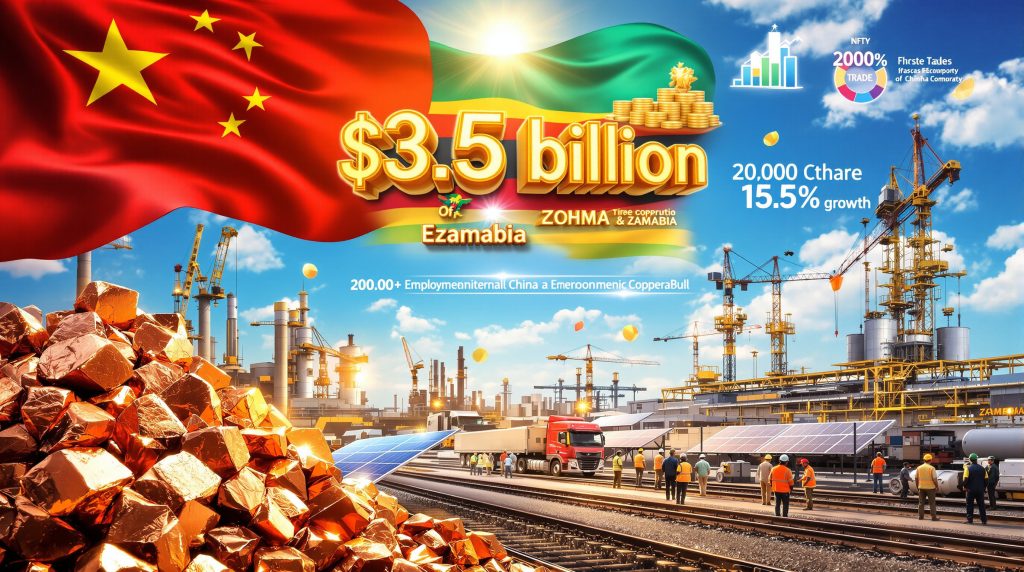Understanding the Strategic Partnership Framework
China Zambia Economic and Trade Cooperation has evolved into one of Africa's most dynamic bilateral relationships, encompassing comprehensive partnerships across mining, infrastructure, manufacturing, and agricultural sectors. This strategic alliance has created robust foundations for sustained economic growth, with both nations benefiting from complementary strengths and shared development objectives.
The partnership framework operates through multiple channels, including government-to-government agreements, private sector collaborations, and specialised economic zones designed to facilitate investment and technology transfer. This multi-layered approach has enabled both countries to leverage their respective advantages while addressing critical development needs.
Recent high-level engagements, including provincial delegations from China's Shaanxi Province, have reinforced the commitment to expanding cooperation across emerging sectors such as clean energy and advanced manufacturing technologies. These initiatives demonstrate the evolving nature of the partnership beyond traditional trade relationships.
How Does the Zero-Tariff Policy Impact Trade Relations?
The implementation of comprehensive zero-tariff agreements has fundamentally transformed bilateral trade dynamics, creating preferential conditions that benefit businesses and consumers in both markets. Furthermore, this policy framework eliminates customs duties on an extensive range of products, significantly reducing transaction costs and improving market access opportunities.
Key Trade Performance Indicators:
- Total bilateral trade volume: Substantial growth trajectory maintained despite global economic uncertainties
- Trade structure improvements: Increased diversity in product categories and value-added exports
- Investment facilitation: Enhanced capital flows supporting industrial development projects
- Market integration: Deeper economic linkages across multiple sectors
The zero-tariff framework particularly benefits Zambian exporters seeking to access Chinese markets, while simultaneously providing Chinese manufacturers with cost-effective access to Zambian consumers. In addition, this reciprocal arrangement has contributed to sustained trade growth and stronger economic ties between the nations, particularly in light of evolving tariffs impact markets conditions globally.
What Are Zambia's Primary Export Commodities to China?
Mining Sector Dominance
Zambia's export profile to China reflects the country's position as a leading global copper producer, with mineral resources forming the backbone of bilateral trade relationships. However, the mining industry evolution continues to reshape opportunities and market dynamics across the sector.
Primary Export Categories:
- Raw copper concentrates: High-grade materials for Chinese manufacturing industries
- Refined copper products: Value-added processing supporting industrial applications
- Critical minerals: Essential materials for technology and renewable energy sectors
- Agricultural exports: Tobacco and other specialised crops meeting Chinese market demands
The global transition toward electric mobility has created new opportunities for Zambian mineral exports, particularly copper and cobalt essential for battery manufacturing. Consequently, this shift positions Zambia strategically within emerging supply chains supporting clean energy technologies, especially regarding critical minerals energy transition requirements.
Value-Added Processing Opportunities
Recent developments in bilateral cooperation emphasise expanding value-added processing capabilities within Zambia, enabling the country to capture greater economic benefits from its mineral wealth. This approach aligns with national development objectives while meeting Chinese demand for processed materials.
For instance, enhanced gold and copper exploration activities continue to identify new opportunities for both nations to benefit from expanded mineral production and processing facilities.
Which Chinese Products Enter the Zambian Market?
Industrial Equipment and Technology Focus
Chinese exports to Zambia demonstrate strategic alignment with the country's infrastructure development priorities and industrial modernisation objectives. This trade flow supports critical sectors including construction, transportation, and manufacturing.
Major Import Categories:
- Heavy machinery: Construction and mining equipment supporting infrastructure projects
- Transportation solutions: Commercial vehicles, trucks, and specialised equipment
- Manufacturing technology: Industrial equipment enabling local production capabilities
- Telecommunications infrastructure: Advanced technology supporting digital transformation
- Solar technology: Photovoltaic systems and renewable energy equipment
Companies specialising in China's renewable energy technology have emerged as significant contributors to Zambia's energy sector development. Advanced photovoltaic solutions offer opportunities to address the country's power generation challenges while supporting sustainable development objectives.
How Significant Are Chinese Investments in Zambia?
Investment Scale and Employment Impact
Chinese enterprises have established substantial economic presence in Zambia through comprehensive investment portfolios spanning multiple sectors. These investments have created significant employment opportunities while contributing to technology transfer and skills development initiatives.
Investment Highlights:
| Sector | Investment Focus | Employment Impact |
|---|---|---|
| Manufacturing | Processing facilities | High direct employment |
| Infrastructure | Transportation networks | Construction jobs |
| Energy | Renewable projects | Technical positions |
| Mining | Equipment and technology | Skilled opportunities |
The investment approach emphasises long-term partnerships rather than short-term extraction, creating sustainable economic benefits for local communities. Moreover, this strategy has resulted in technology transfer opportunities and local supplier development programmes.
The Zambia-China Economic and Trade Cooperation Zone
This specialised economic zone represents a flagship project demonstrating the depth of bilateral cooperation and investment commitment. The Zambia-China Economic and Trade Cooperation Zone attracts both Chinese and international investors through streamlined procedures and comprehensive support services.
Zone Features and Benefits:
- Investment incentives: Competitive tax structures supporting business development
- Infrastructure support: Reliable utilities and transportation connectivity
- Skills development: Training programmes enhancing local workforce capabilities
- Supply chain integration: Connections between local and international businesses
The cooperation zone model has proven successful in attracting diverse investments while creating measurable economic benefits for participating businesses and local communities.
What Role Does Infrastructure Development Play?
Transportation and Connectivity Enhancement
Chinese investment in Zambian infrastructure focuses on improving connectivity both domestically and across regional networks. These projects support broader economic integration while addressing critical transportation bottlenecks that limit trade efficiency.
Infrastructure development priorities include road networks connecting mining areas to ports, railway systems supporting bulk commodity transportation, and telecommunications networks enabling digital commerce. These investments create multiplier effects throughout the economy.
Energy Sector Transformation
Given Zambia's recent energy challenges, Chinese partnerships have become increasingly important in developing power generation capacity and renewable energy solutions. Solar technology partnerships offer particular promise for addressing the country's energy deficit.
Critical Development Priority: Following the country's worst drought in history, Zambia has identified energy infrastructure as an urgent investment priority, targeting substantial increases in power generation capacity to support economic growth.
Recent energy sector collaboration has focused on diversifying power generation sources while improving grid reliability and expanding access to rural communities. These initiatives align with sustainable development objectives while meeting immediate energy needs.
How Do Recent High-Level Visits Strengthen Ties?
Provincial Delegation Impact
Recent visits by Chinese provincial delegations have resulted in concrete cooperation agreements spanning technology transfer, clean energy solutions, and manufacturing partnerships. These engagements demonstrate commitment to expanding cooperation beyond traditional sectors.
The China (Shaanxi) Zambia Economic and Trade Cooperation Exchange Conference, held at the Intercontinental Hotel Lusaka, served as a strategic platform for government and business leaders to network and discuss future joint ventures. This event highlighted the role of provincial-level cooperation in strengthening bilateral ties.
Key Conference Outcomes:
- Clean energy partnerships: Advanced solar technology collaboration agreements
- Industrial cooperation: Manufacturing technology transfer initiatives
- Investment facilitation: Streamlined procedures for new projects
- Skills development: Educational and training programme partnerships
Strategic Government Engagement
High-level diplomatic exchanges have established comprehensive frameworks for expanded cooperation, particularly in sustainable development, technology innovation, and industrial modernisation. These engagements provide political support for business-level partnerships.
Presidential diplomacy has created enabling environments for increased investment flows while addressing regulatory challenges that previously limited business expansion. This top-level support translates into practical benefits for enterprises operating in both markets.
What Are Zambia's Strategic Investment Priorities?
Mining Sector Modernisation Opportunities
With the global transition toward electric mobility accelerating, Zambia's mineral resources present exceptional opportunities for supply chain integration. The country's copper, cobalt, and other critical minerals are essential components in battery technology and renewable energy systems.
According to the Zambia Development Agency, mining represents one of the country's top three investment priorities, reflecting the sector's potential within evolving global supply chains. This strategic focus aligns with international demand for materials supporting clean energy transitions and copper price insights that indicate strong future demand.
Mining Investment Advantages:
- Resource abundance: Extensive mineral deposits supporting long-term operations
- Geographic advantages: Strategic location for regional market access
- Infrastructure connectivity: Established transportation and logistics networks
- Regulatory support: Government commitment to mining sector development
Energy Infrastructure Expansion
Following severe drought impacts on hydroelectric generation, Zambia has prioritised massive expansion of power generation capacity. The country targets over 10,000MW in new capacity, creating substantial opportunities for energy technology partnerships and infrastructure investment.
This ambitious target reflects both urgent necessity and long-term strategic planning, positioning energy investment as both critical and potentially lucrative for qualified partners. Solar technology solutions offer particular promise given Zambia's solar resource potential.
Agricultural Development Potential
Zambia's vast agricultural potential remains largely untapped, with extensive land areas available for cultivation and processing operations. Agribusiness partnerships focus on enhancing food security while developing export market opportunities.
The agricultural sector offers opportunities across the entire value chain, from production technology and irrigation systems to processing facilities and logistics networks. These investments support both domestic food security and export revenue generation.
How Do Economic Cooperation Zones Function?
Operational Framework and Benefits
Economic cooperation zones operate through comprehensive frameworks designed to attract investment while providing tangible benefits to participating businesses and local communities. These zones combine policy incentives with infrastructure support and streamlined procedures.
| Zone Component | Investor Benefit | Community Impact |
|---|---|---|
| Tax Incentives | Reduced operational costs | Government revenue growth |
| Infrastructure | Reliable utilities | Job creation |
| Streamlined Processes | Faster approvals | Skills development |
| Support Services | Business facilitation | Local supplier opportunities |
The zones demonstrate success through measurable outcomes including employment generation, export growth, technology transfer, and local supplier development. These metrics provide concrete evidence of economic impact and development effectiveness.
Investment Facilitation Services
Zone management provides comprehensive support services ranging from investment approval assistance to ongoing operational support. This approach reduces administrative burdens while ensuring compliance with regulatory requirements.
Core Support Services:
- Investment processing: Expedited approval procedures for qualifying projects
- Infrastructure provision: Reliable power, water, and telecommunications connectivity
- Skills development: Training programmes aligned with investor requirements
- Supply chain connections: Links between international investors and local suppliers
What Challenges and Opportunities Exist?
Market Access Enhancement Potential
Continued tariff reductions and trade facilitation measures create expanding opportunities for market access in both directions. These developments particularly benefit small and medium enterprises seeking to enter new markets or expand existing operations.
Trade facilitation improvements include customs procedure streamlining, documentation simplification, and logistics network enhancement. Consequently, these measures reduce transaction costs while improving market accessibility for businesses of all sizes.
Technology Transfer and Innovation
Partnerships in solar technology, manufacturing processes, and agricultural techniques represent significant opportunities for knowledge sharing and capacity building within Zambian industries. Furthermore, these collaborations support long-term competitiveness development.
Technology transfer initiatives extend beyond equipment provision to include training programmes, technical assistance, and ongoing support services. This comprehensive approach ensures sustainable technology adoption and local capability development.
Sustainable Development Integration
Strategic Consideration: Modern cooperation frameworks increasingly emphasise environmental sustainability and social responsibility, ensuring economic growth aligns with long-term development objectives and community benefits.
Sustainable development principles are being integrated into all major cooperation initiatives, from mining operations to manufacturing facilities and infrastructure projects. This approach addresses environmental concerns while supporting social development objectives.
How Does This Partnership Compare Globally?
Regional Leadership Position
The China Zambia Economic and Trade Cooperation serves as a model for similar partnerships across the African continent, demonstrating the scale and depth possible through sustained bilateral cooperation. The comprehensive nature of this partnership extends well beyond traditional trade relationships.
Regional comparisons highlight several distinctive features including the diversity of cooperation sectors, the emphasis on technology transfer, and the commitment to long-term partnership development. These characteristics distinguish the relationship from purely transactional trade arrangements.
International Best Practices
The partnership incorporates international best practices in areas such as environmental protection, community engagement, and sustainable development. This approach addresses global standards while respecting local development priorities and cultural considerations.
Distinctive Partnership Features:
- Sector diversity: Cooperation spanning multiple economic sectors
- Technology emphasis: Focus on knowledge transfer and innovation
- Long-term commitment: Sustained engagement beyond project completion
- Community integration: Programmes supporting local development objectives
What Are the Long-Term Implications?
Economic Diversification Impact
This partnership actively supports Zambia's efforts to diversify its economy beyond traditional mining activities, developing manufacturing capabilities and expanding into new export markets. This diversification strategy reduces economic vulnerabilities while creating new growth opportunities.
Manufacturing development initiatives focus on value-added processing of local resources, import substitution opportunities, and export market development. These activities create employment opportunities while building local industrial capabilities.
Regional Economic Integration
Enhanced China Zambia Economic and Trade Cooperation contributes to broader regional economic integration by improving connectivity and trade facilitation across southern Africa. These improvements benefit not only bilateral trade but also regional commerce more broadly.
Infrastructure investments, particularly in transportation and telecommunications, create positive spillover effects for neighbouring countries while strengthening Zambia's position as a regional hub for trade and investment activities.
Sustainable Development Alignment
Modern cooperation frameworks incorporate sustainable development principles throughout project design and implementation, ensuring economic growth supports environmental protection and social advancement objectives.
This alignment with global sustainability goals positions the partnership as a model for responsible economic cooperation while addressing pressing development challenges including energy access, food security, and environmental protection.
Disclaimer: This analysis is based on publicly available information and should not be considered as investment advice. Economic cooperation partnerships involve various risks and uncertainties that may affect outcomes. Readers should conduct their own research and seek professional advice before making investment decisions.
Note: Information regarding trade volumes, investment figures, and economic projections reflects publicly available data and official statements. Actual results may vary due to changing market conditions, policy adjustments, and other factors beyond the control of participating parties.
Ready to Invest in the Next Major Mineral Discovery?
Discovery Alert instantly alerts investors to significant ASX mineral discoveries using its proprietary Discovery IQ model, turning complex mineral data into actionable insights. Understand why historic discoveries can generate substantial returns by visiting Discovery Alert's dedicated discoveries page, showcasing examples of exceptional outcomes, and begin your 30-day free trial today to position yourself ahead of the market.




